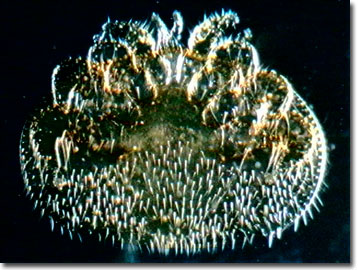Darkfield Digital Image Gallery
Varroa Mite (Varroa jacobsoni)
Known as the varroa mite, Varroa jacobsoni is an ectoparasitic member of the class Arachnida found on honeybees (genus Apis). Originally described from Java in 1904, the mite was located in Hong Kong and the Philippines by 1963 and imported to the United States on infected queen bees by 1979. Now the parasitic mite has spread to most of North America except for isolated locations in Canada.

In Florida, where thousands of migratory bee colonies are moved annually, this parasitic mite is found on flower-feeding insects such as the American bumblebee (Bombus pennsylvanicus), syrphid flies (Palpada vinetorum), and scarab beetles (Phanaeus vindex). Although, the varroa mite cannot reproduce on other insects, these hosts serve as a means of spreading the acarian species.
Shaped like crabs, adult female mites are brown in color and have dimensions of about 1.5 millimeters long and 1.75 millimeters wide. Well adapted for their hosts, the curved bodies of the ectoparasite fit into the abdominal folds of the adult bees and are held there by specialized ventral setae. This habit protects the hitchhikers from the normal grooming habits of the bees. The male mites are yellowish with lightly tanned legs and a spherical body that is approximately 0.85 millimeter in diameter. Males feature modified chelicerae that transfer sperm to females.
The life cycle of the varroa mite is so synchronized with its honeybee host that speculations have surfaced about hormones or pheromones of the host being necessary for the mite to complete its development. Female mites lay eggs in the bee brood cells. Developing mites feed on developing honeybee larvae, and then male and female mites copulate in the cell. The male then dies, but pregnant females emerge from the cell along with a bee host, or seek another cell to repeat the cycle. The longer the postcapping period of the honeybees, the more time there is for more female mites to develop, leading to a heavier episodic infestation. Once the cells are capped in the hive, mites stop invading. It takes only seven days for the female mite to reach sexual maturity and six days for the male. If the worker bee host does not emerge after 21 days in the hive from its egg phase, the mite dies.
As the most serious parasites of honey bees, Varroa jacobsoni is of great economic importance not only to honey producers, but also to farmers and horticulturists that depend on bee pollination for their crops such as alfalfa, ornamental flowers, and oranges. If left unchecked, weakened colonies may die for lack of workers to manage broods and gather nectar. Under ideal weather conditions, as occur in Florida, bee colonies may fail in only a few months. This may appear to be a case of a "bad parasite" wiping out its host, but within its native range, the original hosts, Apis cerana and African honey bees (A. mellifera scutellata, support populations of mites without collapsing.
Contributing Authors
Cynthia D. Kelly, Thomas J. Fellers and Michael W. Davidson - National High Magnetic Field Laboratory, 1800 East Paul Dirac Dr., The Florida State University, Tallahassee, Florida, 32310.
BACK TO THE DARKFIELD IMAGE GALLERY
BACK TO THE DIGITAL IMAGE GALLERIES
Questions or comments? Send us an email.
© 1995-2022 by Michael W. Davidson and The Florida State University. All Rights Reserved. No images, graphics, software, scripts, or applets may be reproduced or used in any manner without permission from the copyright holders. Use of this website means you agree to all of the Legal Terms and Conditions set forth by the owners.
This website is maintained by our
Graphics & Web Programming Team
in collaboration with Optical Microscopy at the
National High Magnetic Field Laboratory.
Last Modification Friday, Nov 13, 2015 at 02:19 PM
Access Count Since September 17, 2002: 11288
Visit the website of our partner in introductory microscopy education:
|
|
